|
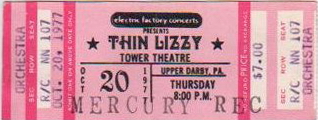
Big thanks to Ron Fahnestock
for sending me these wonderful photos
http://www.homeatfirst.com/THIN-LIZZY.HTM
I met Phil and Lizzy at
the Tower Theater in Upper Darby PA in
1977, and photographed them in concert that night after spending the
afternoon
back stage with the lads and their road manager. The resulting
photographs,
which were submitted but not used for use on the cover of 1978s Live &
Dangerous
album, have never been published, except on my web site.
In all there may be a dozen photos that might be of interest to your
readers.
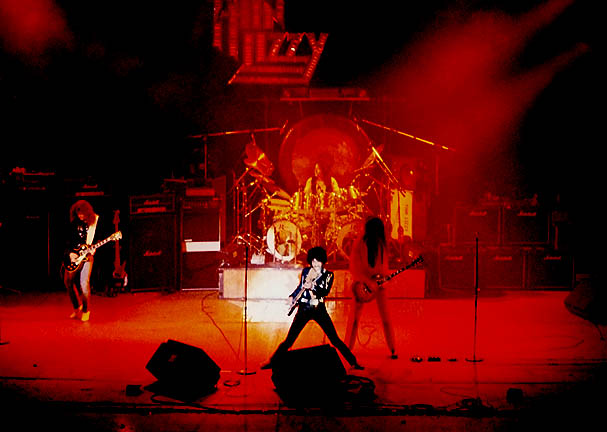
Hope you like the image, which was one of 7 (and one of 5 that show the
whole band on
stage together) that I shot from the rocking balcony at the Tower
Theater, a great place
to see a rock concert. The other 15 images were shot from the orchestra
pit directly in
front of the band and include a number of photos of individual members
(except for
Brian Downey, who was very difficult to get behind his kit).
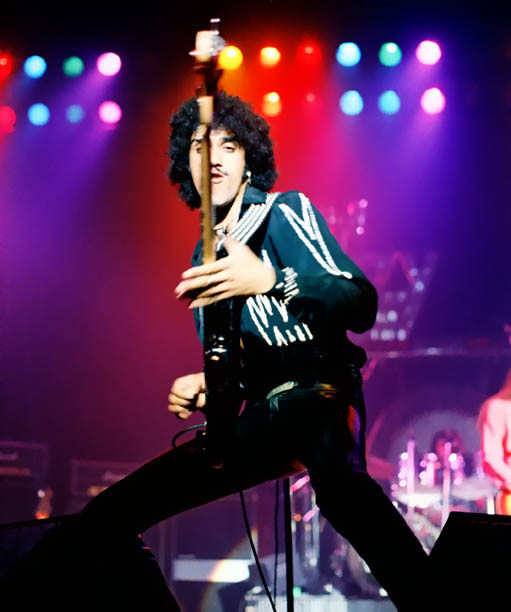
Phil Lynott -- Irish Elvis
-- and his phallic bass.
Shot from the orchestra pit without a flash (hence the slight
blur).
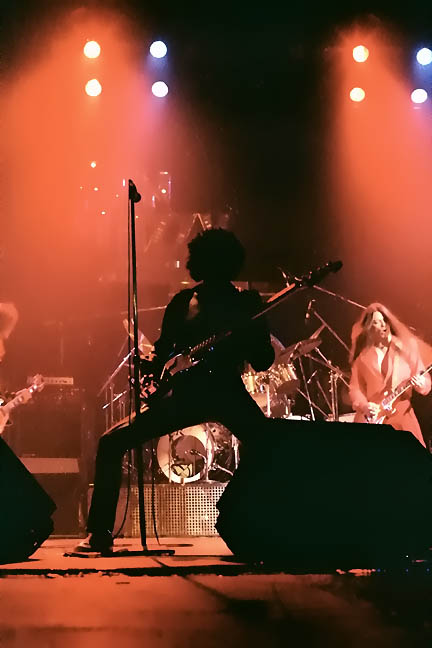
Phil (in full shadow) and Scott Gorham (illuminated in peach or
Creamsickle).
Shot from the orchestra pit without a flash (hence Phil in darkness).
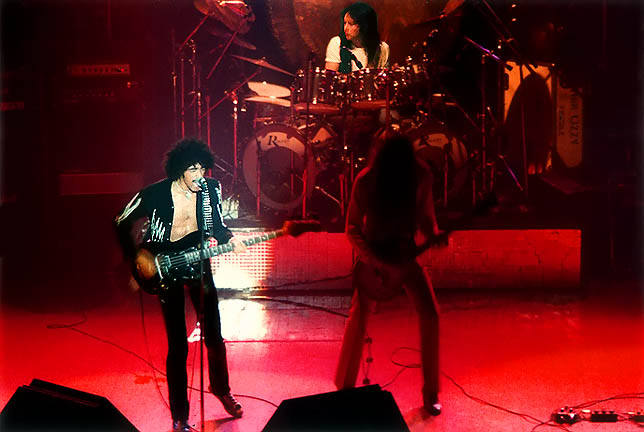
One of the few shots I took where you can see Brian Downey reasonably
clearly.
Phil, too. Scott, not so much. But a nice action shot from the
bouncing balcony.
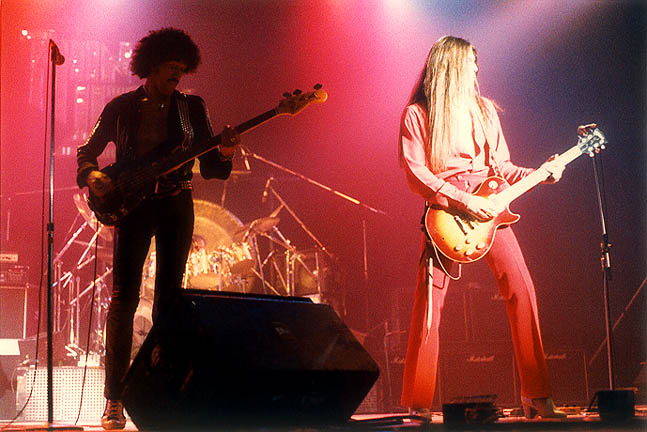
A shot I like a lot. This version is basically "natural" -- colors and
composition as
the camera saw the scene: Scott overexposed, Phil underxposed,
lighting good,
but a little muted.
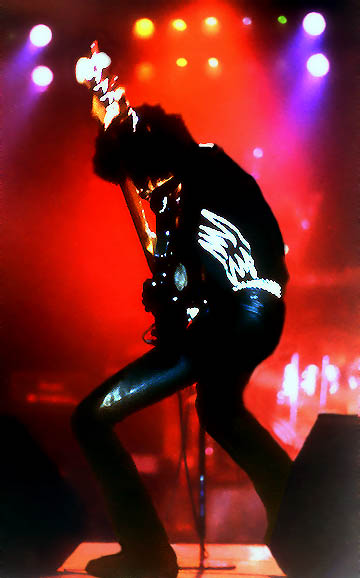
Phil contorting with his Fender bass. Phil was very active on stage and
while the
band's guitarists held poses for several seconds at a time, Phil
could hardly hold
still. His repertoire of movements seemed unrehearsed, while Robbo
and Scott
seemed to be heavily choreographed.
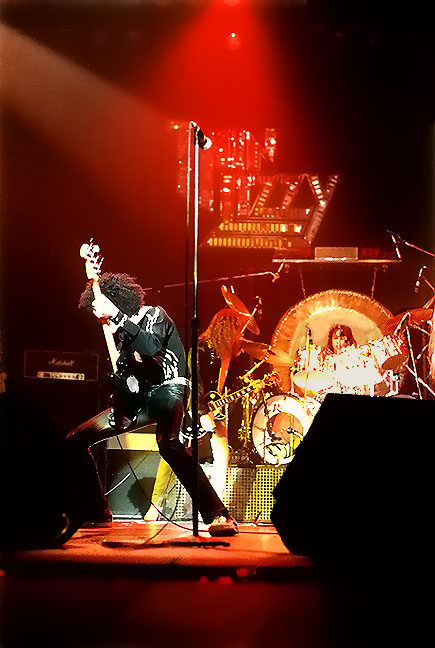
Phil in another contortion fronts the two Brians in another action scene
I took from
the orchestra pit. The guitarists rarely left their
respective territories on stage right
and stage left to visit the drummer. Here Robbo is urging on Brian
Downey while
Phil requires no urging.
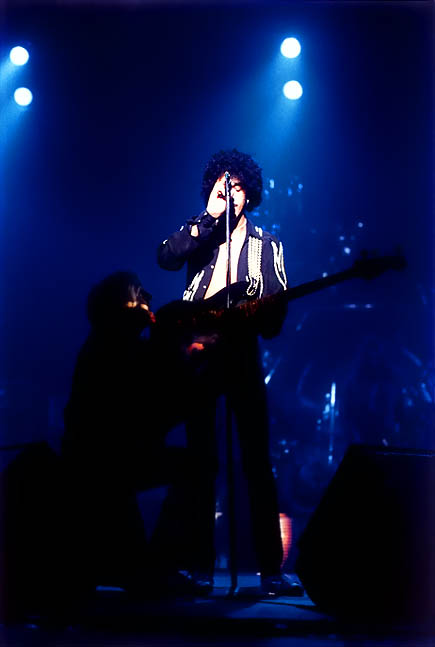
Occasionally things were quiet on stage: usually between songs or at the
beginning
of a ballad, like "The Cowboy Song". Here we see a roadie adjusting
Phil's mic stand.
The roadie's kneeling pose combine with the deep blue lighting to
give the moment
a reverent, almost worshipful, aspect. Such a respectful pause would
not last long.
Soon enough Phil would be whipping Thin Lizzy into a frenzied high
gear, and the
Tower Theater audience would be standing, bouncing, thrilling.
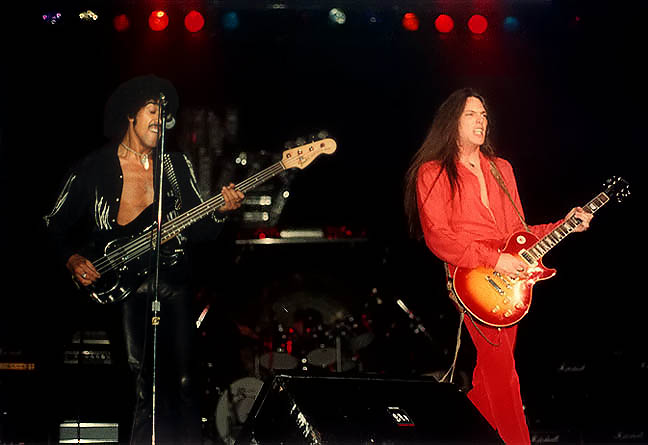
Phil and Scott in action. As anyone who ever played bass and sang lead
knows,
doing these two things at once is not easy. Phil played some complex
bass lines
and still managed to be creative with his vocals -- changing lyrics
and addressing
the audience. Phil often checked his hand position on the bass
visually while he
sang. Scott was rarely doing two things at once, and rarely looked
at his fretboard,
even during the complex guitar choreography of harmony duets with
Brian
Robertson.
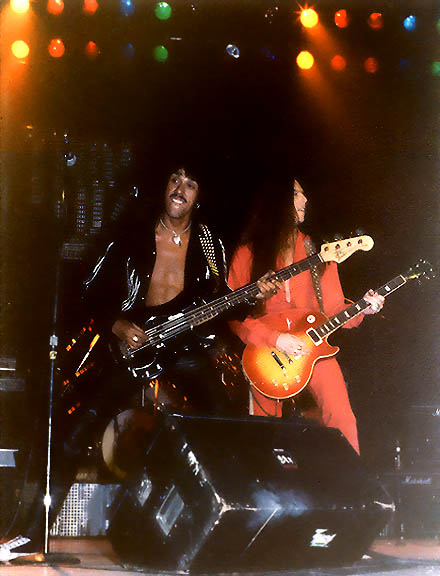
Phil and Scott again. This time Phil isn't encumbered by singing and can
focus on
the bass -- and moving with the music, driving the audience with his
aggressive
posturing.
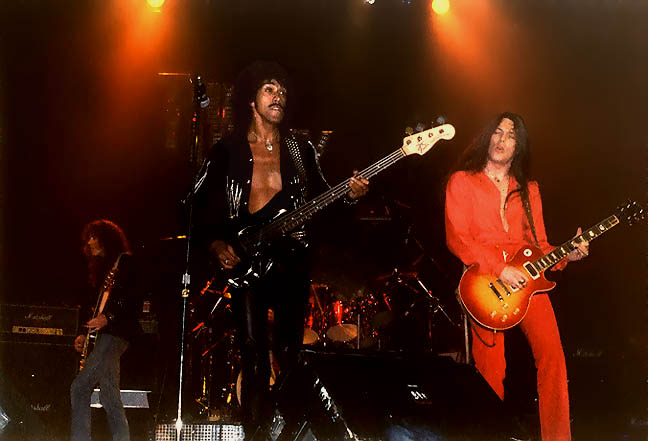
Robbo, Phil, and Scott during an instrumental section. From their hand
positions
and their facial concentration, it is likely that Robbo and Scott
are in the midst of
one of their guitar harmony duets that was as much a signature of
Thin Lizzy as
Phil's husky voice and rock 'n roll storytelling. Note Phil's
concentration, too. In
a four-piece band, when both guitars are playing lead, the bass
player and drummer
are responsible for laying down a solid bottom and keeping the song
driving, tight,
and powerful.
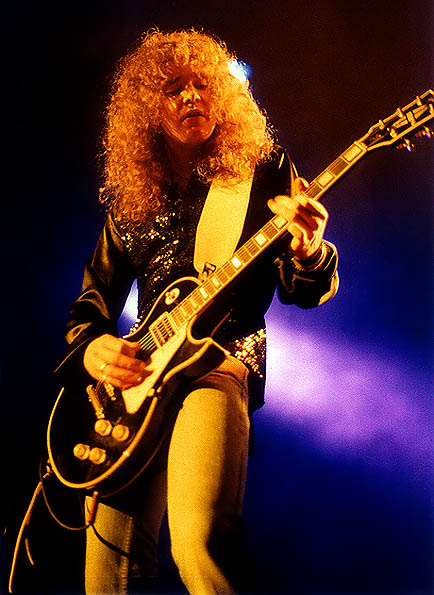
Brian "Robbo" Robertson in shades of yellow and blue. Thin Lizzy's flying
Scot
brought a heavy blues guitar sound to the band to compliment Scott
Gorham's
driving West Coast guitar style. Both guitarists used versatile
Gibson Les Pauls
as their primary instruments. Les Pauls are known for their many
voices, but
Robbo and Scott -- despite their different backgrounds and stylistic
preferences --
played their harmony duets in the same guitar voice, as if one
guitar overdubbing
itself. Other notable bands who used guitar harmonies -- The Allman
Brothers
come to mind -- coupled distinctly different guitar voices, creating
a blend that
could at times sound discordant. Thin Lizzy's twin guitar voices
never missed:
like the vocal harmonies of Don & Phil Everly, the guitar mix of
Robbo and Scott
was smooth, effortless, natural, and as tonally fraternal as a band
of brothers.
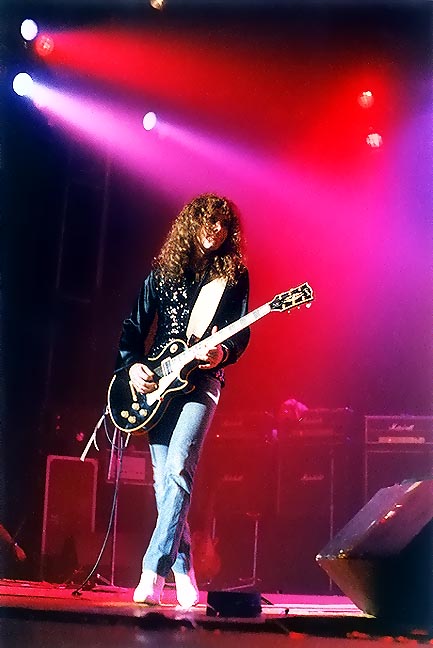
Another shot of Robbo -- my favorite of Brian Robertson -- shows the
guitarist's
relaxed confidence and stage swagger in one of his characteristic poses,
looking
somehow unaffected by the dramatic set lighting and the sound
pressure from his
wall of Marshall cabinets. Just
another day at the beach for Mr. Robertson.
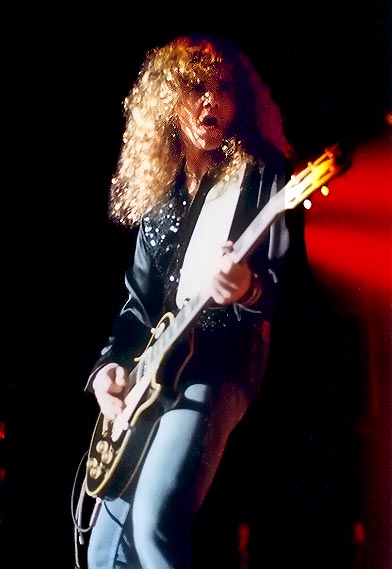
Later, when I returned to the orchestra pit in front of the stage, Robbo came
close
during one of his urgent, menacing leads. I understand he and the
band had a rocky
history and that he left Thin Lizzy less than a year after this photo.
But this evening
there was nothing but great harmony and teamwork among all four players.
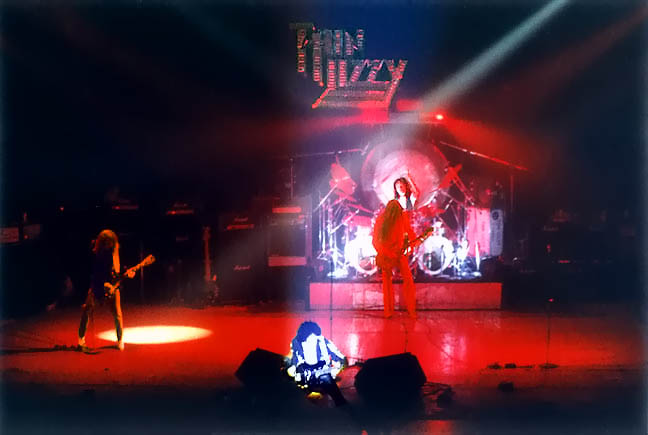
In this horizontal shot taken from the balcony Phil squats between his
monitors,
revving up the crowd in the first row behind the orchestra pit. Robbo
and Scott focus on
what might be the "siren" duet of "Jailbreak", judging by the flashing
rack of police
cruiser emergency lights mounted behind Brian Downey's gong.
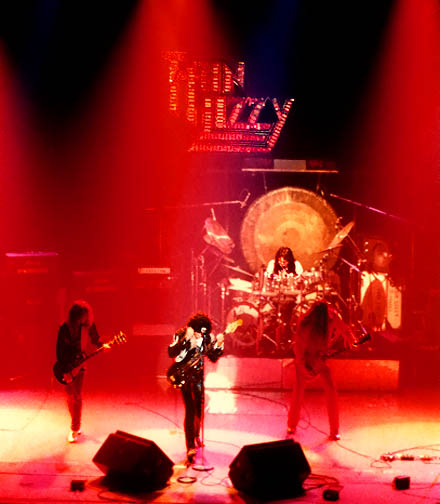
This band portrait from the balcony shows the band with heads bowed. I
don't recall
if I caught them just as they were ending a song -- as Phil's raised
right hand suggests --
or whether the band was in the midst of a demanding instrumental section
that
required the focus of each player on his instrument. My guess is the
former, because
of the full shower of red light illuminating the stage, providing a
crescendo of color
that would match the swelling of a final chord.
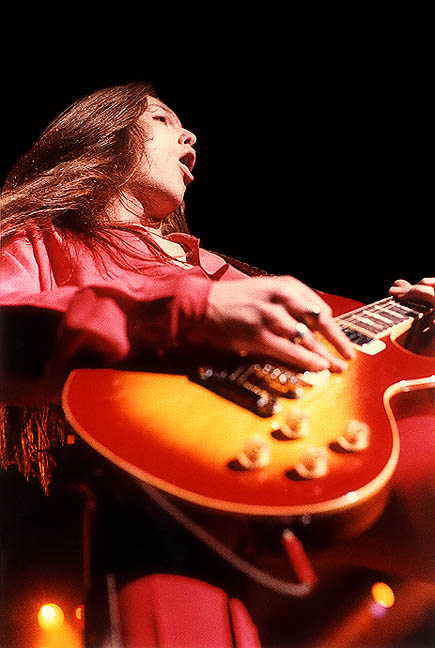
The shot of Scott Gorham may be the best photo of all I took that
evening. He came
to the edge of the stage to solo in a spotlight, and I didn't miss.
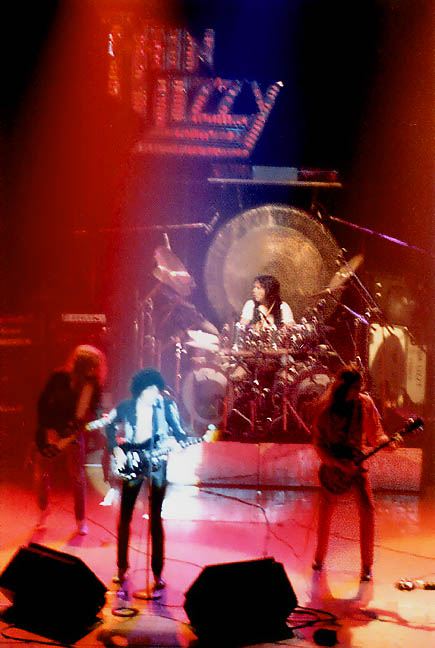
Two more vertical
shots from the balcony:
One, unfortunately, has Phil overexposed and washed out, but its image
of drummer
Brian Downey is as clear and well-lit as I got him that evening.
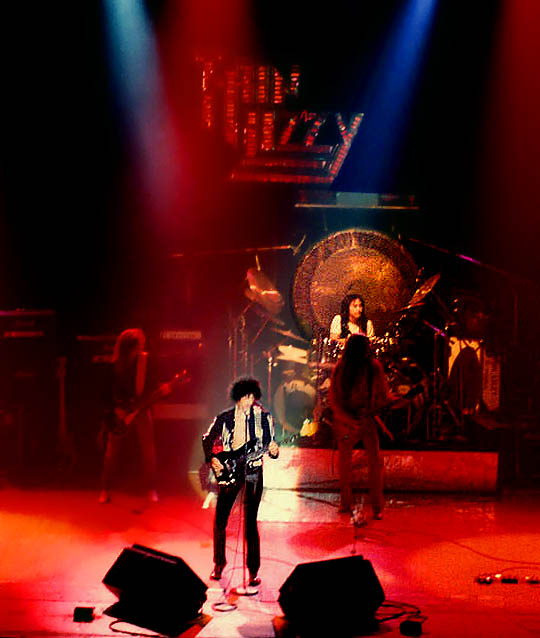
The second captures Phil in the spotlight with minimal blur.
The still photos with intense colors barely hint at the frenzied
action of the band
accompanied by rapid-fire stage lighting choreographed to the changing
dynamics of
the music. Photographing Lizzy in the dark theater without a flash was a
challenge akin
to shooting an exciting football game at night.
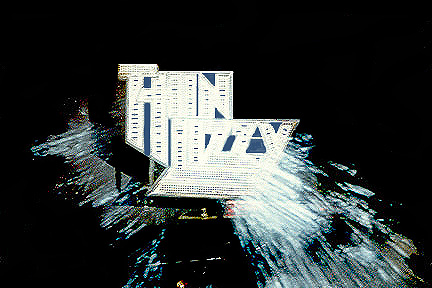
Finally, the odd shot of
the exploding Thin Lizzy logo is a curiosity your readers might
enjoy. It is somewhat blurry, as it was taken from the rocking balcony
with a long-lens.
When it happened, it caught me by surprise. In those days before
automatic focus and
computerized exposure selection, I pointed my manual Pentax camera at
the logo and pressed the shutter button.
I was lucky to catch the explosion with reasonable focus and exposure.
But then, why not? I had been lucky all day: meeting the band at the
height of their
popularity in the USA, being invited to shoot their extraordinary concert,
and having
free access to the theater to do so. My luck continues: I'm lucky enough
to have found
an audience interested in these old photos thirty-three years on. Hope
you enjoyed them.
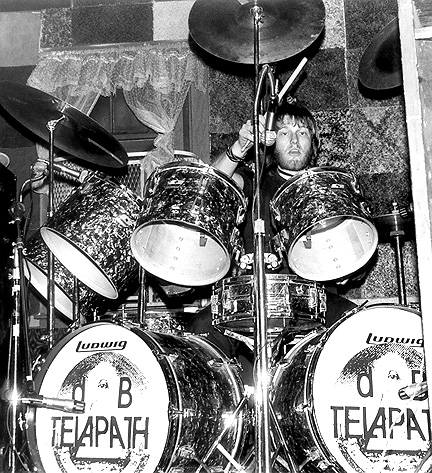
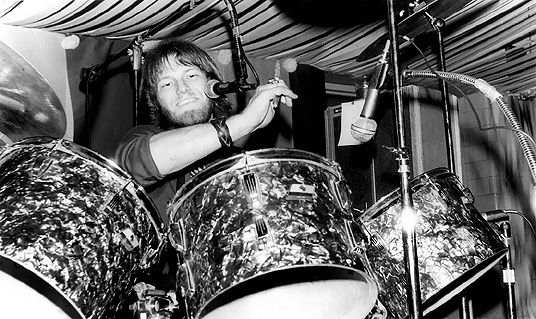
Photographer Ron Fahnestock ("Ronnie Stockton") performing with his
band,
Telapath, in 1977. The Philadelphia native was invited to photograph
Thin Lizzy
at its October 20 concert at Philadelphia's Tower Theater (actually
in Upper Darby,
Pennsylvania) not because he was a musician, but because he was also
a
professional photo-journalist with a Pennsylvania newspaper. The
photos were
to be considered for use for the cover of Lizzy's "Live and
Dangerous" album.
However, the recording made that evening was not used for "Live and
Dangerous",
and the pictures, therefore, were not used. Ironically, the October
20 Tower
Theater concert recording has become the source of a 2009 release
("Still
Dangerous") and is also available on the internet. Happily the
pictures of the
concert remained in photographer's archive, essentially not seen by
Lizzy
fans and the general public until now.
|